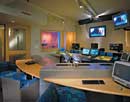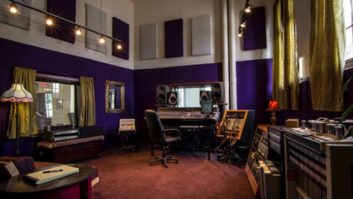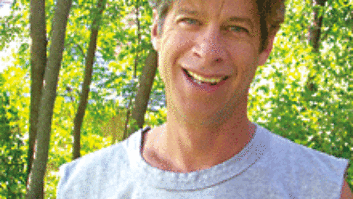
One of three 5.1 commercial post rooms at Tonic
Longtime New York audio post vet Peter Fish opened his own audio post facility, Tonic, on the East side of Manhattan nearly three years ago. In a partnership with WNET, Tonic also built a post facility on West 33rd Street. At that time, audio in the Big Apple had taken a big hit due to the long strike, a declining economy and a gradual migration of work away from the more expensive city centers to other regions of the country — and even north across the border.
Checking in with the composer today, it seems that the gamble of building during tough times paid off. Although the broadcast community has taken a bit longer to catch on to surround sound mixing, the kind of episodic work that Fish composes for on a regular basis is all being aired in 5.1, and Tonic is a huge beneficiary of the change in format.
“I’m comfortable stating that we’re dong more 5.1 audio post work than anyone in town,” says Fish. “And there’s a simple reason for it. Many — if not most — of the rooms in town service the advertising community almost exclusively and spots are still mixed in stereo.
“With all of the episodic television work we do [Fish has been nominated for two Daytime Emmys this year, both for his work on the long-running ABC soap All My Children], we’ve gotten more and more experience mixing in 5.1 because this work has all moved over to surround. HDTV took a while to catch on, but it’s happening now, and there are more broadcast streams coming online, including an expanded number of cable outlets. Not only is the main programming being mixed in 5.1, but producers are now asking for promos to be mixed in surround, as well. We’ve become the most experienced 5.1 place in town, and it’s really helped to keep our work flow steady.”
One of the principal challenges mixers have had during the transition period stems from the need to create both surround and stereo mixes. With budgets scrutinized closely, how many billable hours can be spent folding down a 5.1 mix? Fish says there is no dilemna: “The answer to the problem is the Euphonix System 5. It’s unbelievable!”
Tonic installed three System 5s during its initial construction phase. With the exception of periodic software updates, which comprise mostly of maintainence grooming, the boards have had no work done to them since installation. “I know that everyone worries about the time it will take to fold a 5.1 mix down to stereo, but the System 5 has an incredible brain. All we do is tell it to execute the stereo mix and it invariably creates a perfect 2-mix. Don’t ask me how!
“We’ll take hours creating a surround mix with both subtle and extreme moves, and the System 5 knows just what to do with the fold-down. Of course, we check all of our stereo mixes before they go out the door, but I don’t think we’ve even tweaked a mix more than a couple of times — if that — in the two-and-a-half years that we’ve had the consoles.”
In addition to the episodic television work that he routinely brings in, Fish also scores feature films on occasion. “One of the last films I scored is called A Tale of Two Pizzas,” he says. Shot on-location in Yonkers, N.Y., the film was directed by Victor Sassone and stars Frank Vincent Pastore. “It will be released by Newmark/Echelon in the spring [2004]. Every note of that score was mixed in 5.1. When it came time to make a stereo print, we didn’t have to move a muscle.”
All of Tonic’s rooms are Pro Tools — centric. However, Fish has opted not to replace any of his company’s 5.1.3 systems with newer versions of Pro Tools. “We haven’t made the move to Pro Tools 6, and we’re still running OS 9 on all of our systems. With eight workstations in-line, we’re looking at replacing the entire fleet and that includes all of the plug-ins we use. For now, we’re sticking with the earlier versions of Pro Tools that continue to serve us and our clients well.” In addition to three Euphonix System 5 consoles, Tonic also owns a pair of Neve Libra boards, which are housed in the Westside facility. Several smaller rooms use Pro Tools with a Digidesign Control 24 surface and one uses Digidesign’s ProControl unit.
His workstations are au courant compared to his sampler of choice, however. In fact, when asked, “What’s a Synclavier?” Fish considers — for just a moment — that the question might be legitimate. “I know, the Synclavier is considered ancient by many people, but it’s still the best sampler in the world. If the system hadn’t been redesigned to allow it to import .AIFF and .WAV files, it might be archaic by now. But I can load any sample library into my Synclavier, and both Jun Mizumachi [Tonic’s in-house sound designer] and I have huge libraries of our own samples that we’ve created in the Synclavier, which we can’t part with.”
Besides a collection of Auratones and some television speakers used to check broadcast mixes, Tonic exclusively uses Genelec monitors. “I’m a big Genelec fan,” says Fish. “I find them to be the least-hyped speaker I’ve ever heard. Even their smallest cabinets let you pump a lot of air through them.”
Life has gotten a lot easier when it comes to the delivery phase, according to Fish. “We still mix to DAT and DA-88, but more and more we’re just putting .AIFF or .WAV files up on the Net. Generally what happens — especially if we’re working with an out-of-town client — is that we’ll post a lower-resolution MP3 of a clip using Fetch software. If it’s accepted, we’ll post the file a second time at 16 bits and 44.1 kHz. If needed, we can still burn a CD. Regardless, we’re always giving them product in a digital format.
“FTP delivery is attractive because it’s immediate,” Fish adds, echoing comments heard throughout the industry about how FedEx is no longer fast enough for clients. “Jun did a piece yesterday for an Italian sports network. We squashed the MP3 using a 2:1 compression scheme and put it on our site. The client approved it and — bam! — we sent the uncompressed version back to them instantly.”
Before calling Mizumachi to the phone, Fish comments on the state of the business. “It’s on the way up, but you have to know where to find it,” he says of New York in general. “The middle ground that once existed, the meat-and-potatoes work, is gone. People have simply stopped mixing this kind of work at outside facilites. For example, we used to mix 40 to 50 episodes of the A&E channel’s Biography series each year. That figure has gone down to zero. It’s not that the work has gone to another post house, the client is mixing the audio themselves in their Avid system.
“On the other hand, no one is going to mix 5.1 in an Avid room. They don’t have the skill, the equipment or the room that’s needed to handle this work properly. If a job is going to be played out of a stereo television, many people question how good the audio needs to be. However, the surround sound market demands a different level of quality and will for some time.”
Mizumachi, a Tokyo native who came to New York in 1977, considers Tonic the perfect environment for him. A university graduate who took a political science degree in Japan, Mizumachi learned the recording business during his stint as a gofer at Lavsky Music. After leaving that shop, Mizumachi spent time at Crew Cuts before heading off to the University of Howard Schwartz.
“Howard Schwartz is a great place to work, but I wanted to be around musicians and composers, not just mixers and engineers. Tonic is a creative music house that also does post, and that’s perfect for me. I’m very interested in the relationship of sound to picture and color. These days, it’s so easy to record sounds outside and then bring them into a computer or the Synclavier for processing. Creating sounds that have never been heard before is the main goal. I might spend two days building the sounds that will go into a two-second logo. We have such fantastic tools these days, there’s a lot of great construction that can be achieved.”





